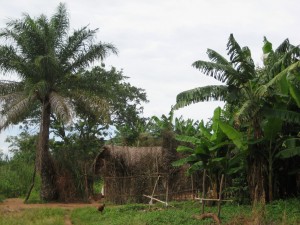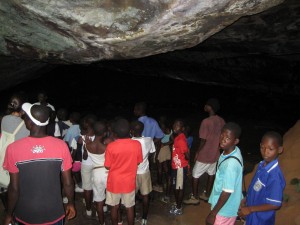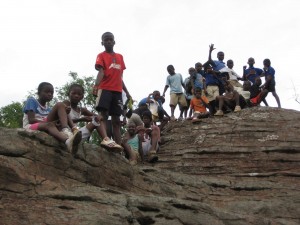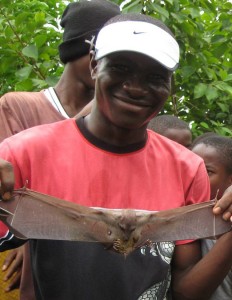Volunteer Spotlight: Bouyem Bat Caves
We were fortunate to be able to join any school field trips during our stay. One trip was an excursion with the Primary 4 class. With the 26 students we piled onto the old school bus and headed off to the Buoyem Bat Caves.
Although the town of Bouyem was only located 8km away, the road there was quite bad. There were large ruts in the road cut out by the heavy rains and the bus struggled through it. Luckily we were warned that we would need long pants, shoes, and hats for the day because the trails and caves would be muddy. We had to pick up a guide first from the town before traveling to the trail head.

The cave went in fairly deep, required getting low again but then opened up to reveal caverns with a ceiling high enough to stand in. We could hear the bats in the cave before we entered. The guide explained that these were smaller bats, but there were thousands of them inhabiting the caves. We could not see the bats at first, only hear them whizzing by our heads. In this cave, there were two openings in the ceilings that let natural light inside. The cave was said to be inhabited by the local tribes people seeking refuge during a war many years ago. This was seen by the evidence of cave drawings and worn rock carvings present on the cave floors and walls.

On our way to the third and final cave, we stopped upon a rock face that had an amazing panoramic view of the lush countryside. The children had a blast playing on the rocks and it was difficult to get them to leave. We finally arrived at the last cave which the guide described as containing much larger bats. He also mentioned that we would not be leaving through the same way we entered. This cave was the most impressive and also had the most history to it. It was discovered by hunters for the Ashanti tribe. They caught a bat, cooked it, fed it to a dog, and when they realized the dog did not die, they knew they could eat the bats. They held the bats as sacred and bat meat became a large part of their diet. Eventually a war broke out, and the chiefs had to hide in the caves for shelter. Some people died in the caves, and so out of respect, our guide did a ceremonial libation to the chiefs before we entered. He took some schnapps, spit it into the air then said a prayer and poured it on the ground. He offered for us to drink some, but because we wanted to hike out alive we kindly refused. The libation was to ensure nothing bad would happen to us in the cave.

This cave again required us to crawl on our hands and knees, but this time through a narrow passage. Bats were flying everywhere as we tried to maneuver through a small tunnel. It was quite the experience. The tunnel finally opened up to a large room with a ladder to climb out. We climbed the ladder and then had to scurry up vines to fully get out of the caves.
The guide caught one of the larger bats and brought it outside for us to hold. Its wingspan was about a foot and a half in length and it was one of the weirder things I have ever held. Its bones were so thin and light I thought it might break when it flapped its wings in my grasp. Its wings were made out of a flexible and stretchy, leathery skin. The bat tried biting me when I held it, so I held it just long enough for a picture before handing it to an eagerly awaiting student.

The tour was finally over and we headed back to where our bus had last left us. We had come full circle and the trip had taken a little more than two hours, not bad with all the kids.
